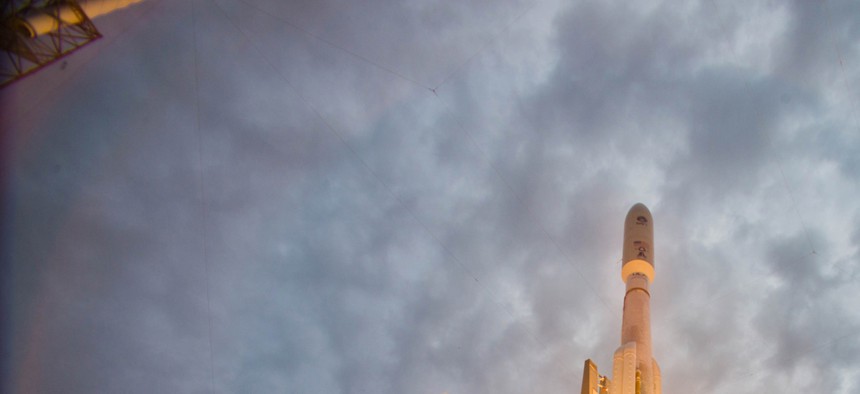
An Atlas V rocket launches the Navy's Mobile User Objective System 2 satellite from Space Launch Complex-41 at Cape Canaveral Air Force station, Fla. U.S. Navy photo courtesy of NASA by Patrick H. Corkery
How 3D Printing Could Help Replace Russian Rockets
The Pentagon could field an alternative to the Russian-made RD-180 rocket engine faster, but the technology is unproven. By Marcus Weisgerber
As the Pentagon looks to develop a replacement for the Russian engine that blasts the Atlas V rocket into orbit, two U.S. companies have been working on a little-known project that could speed up the process.
Dynetics, of Huntsville, Ala., and Aerojet Rocketdyne, of Sacramento, Calif., are already building a replacement engine that could power the Atlas V for military launches and future NASA manned space launches. Much of the engine has been built using a 3-D printing technique know as additive manufacturing.
“Going to additive manufacturing is going to be one of the biggest cost and time savers on this engine,” said Steve Cook, director of corporate development at Dynetics. The team has built a key rocket engine part, know as the pre-burner, with a new manufacturing process for this type of part. What typically takes 15 months, Cook said, they did in 15 days.
“It’s what is used to generate the hot gas that turns the turbo pump on the main engine,” he said.
The company plans to test the part before the end of the year.
Additive manufacturing could save substantial time and money in engine development, but the technology is still unproven, said Marco Caceres, senior analyst and director of space studies at the Teal Group consulting firm. “Right now, what the Air Force needs with regard to a new engine is precisely that, to save a lot of time and money,” he said.
RELATED: BOEING AND SPACEX TAPPED TO FREE NASA FROM RUSSIAN LAUNCHES
Dynetics and Aerojet Rocketdyne have been working on the project for two years, long before the replacement of the RD-180 became part of the common vernacular in defense circles.
The U.S. Air Force launches many of the military’s communications, reconnaissance and navigation satellites on the massive Atlas V rocket. The powerful and reliable RD-180 engine blasts the Atlas V rocket during the boost phase, the first four minutes-or-so during launch. The engine and booster then disconnect and a second engine, the RL-10, propels the payload into space. Aerojet Rocketdyne makes the RL-10.
Souring relations between Washington and Moscow of the past year following Russia’s invasion of Ukraine has put American access to the RD-180 in question. In response to U.S. sanctions levied against Russian firms, Russian Deputy Prime Minister Dmitry Rogozin in May said Moscow would no longer export the RD-180 to the U.S. military. But that has not happened as Atlas V-maker United Launch Alliance received engines in August.
Dynetics director of corporate development
Still, this has prompted the White House, Pentagon and Congress to support a project to build a U.S.-made RD-180 replacement. Members of Congress on both sides of the political aisle have unified in their support for a replacement engine. Last month, 19 lawmakers sent a letter to President Barack Obama pushing for an RD-180 replacement by 2019.
“The path forward requires both careful consideration and decisive action,” they wrote.
Congress recently blessed a Pentagon request to realign $40 million for the replacement engine effort.
The U.S. government scaled back its development of liquid rocket booster technology when it decided to use the Russian RD-180 in the 1990s, said Cook, who worked at NASA for 25 years and served as a Ares rocket program manager.
“We dialed way back in the investments we were making,” Cook said. “This is about recapturing and reclaiming our technology, bringing it back to this country and being able to control our own destiny.”
The Air Force in August asked rocket engine companies to send in thoughts on how it should go about replacing the RD-180. Pentagon officials are now figuring out how to move forward.
“I think that there is close to a consensus of the administration that we need to find a way to remove the dependency [on the RD-180],” Frank Kendall, the Pentagon’s acquisition chief, said in September. “[W]e're looking for the best course of action to do that. We haven't made a decision yet.”
Next week, Deputy Defense Secretary Robert Work is expected to convene a Pentagon panel to discuss the way ahead for the program, according to industry sources.
In addition to the Dynetics and Aerojet Rocketdyne team, other companies interested in engine replacement include Blue Origin, a company established by Amazon founder Jeff Bezos. It has partnered with United Launch Alliance. In addition, ATK is pitching a solid-fueled rocket engine. The Blue Origin and Dynetics-Aerojet Rocketdyne engines are liquid-fueled.
There are many divergent estimates for how much a replacement engine might cost and how long it would take to build. These range from hundreds of millions of dollars to as high as $5 billion and five to seven years.
“Basically nobody knows,” Caceres said. “If you see so much divergence in these estimates, then ultimately what it tells me is that everybody’s guessing and they’re hoping.”
The Dynetics and Aerojet Rocketdyne team believes it could build a prototype engine in about two-and-a-half years of a Pentagon contract award and have a flyable engine by 2019, Cook said.
Regardless of the results, the government will own the intellectual property that comes out of the Dynetics-Aerojet Rocketdyne project.
“The government can take that and provide it to other competitors in a full and open competition … thereby increasing the knowledge of the field in terms of getting more competitive proposals,” Cook said.
NEXT STORY: Navy Picks Dell for Cloud Email Pilot Program




